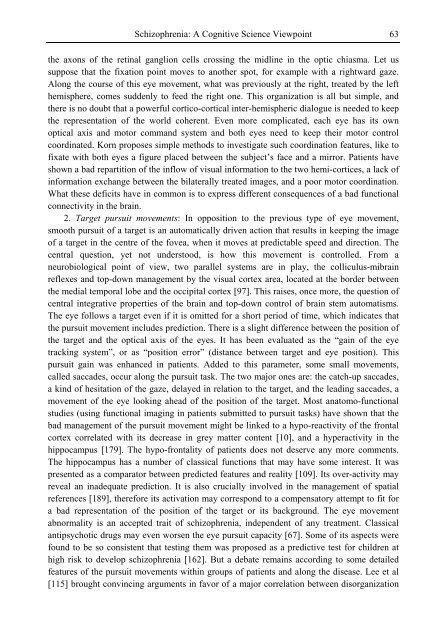Schizophrenia Research Trends
Schizophrenia Research Trends
Schizophrenia Research Trends
- No tags were found...
Create successful ePaper yourself
Turn your PDF publications into a flip-book with our unique Google optimized e-Paper software.
<strong>Schizophrenia</strong>: A Cognitive Science Viewpoint 63the axons of the retinal ganglion cells crossing the midline in the optic chiasma. Let ussuppose that the fixation point moves to another spot, for example with a rightward gaze.Along the course of this eye movement, what was previously at the right, treated by the lefthemisphere, comes suddenly to feed the right one. This organization is all but simple, andthere is no doubt that a powerful cortico-cortical inter-hemispheric dialogue is needed to keepthe representation of the world coherent. Even more complicated, each eye has its ownoptical axis and motor command system and both eyes need to keep their motor controlcoordinated. Korn proposes simple methods to investigate such coordination features, like tofixate with both eyes a figure placed between the subject’s face and a mirror. Patients haveshown a bad repartition of the inflow of visual information to the two hemi-cortices, a lack ofinformation exchange between the bilaterally treated images, and a poor motor coordination.What these deficits have in common is to express different consequences of a bad functionalconnectivity in the brain.2. Target pursuit movements: In opposition to the previous type of eye movement,smooth pursuit of a target is an automatically driven action that results in keeping the imageof a target in the centre of the fovea, when it moves at predictable speed and direction. Thecentral question, yet not understood, is how this movement is controlled. From aneurobiological point of view, two parallel systems are in play, the colliculus-mibrainreflexes and top-down management by the visual cortex area, located at the border betweenthe medial temporal lobe and the occipital cortex [97]. This raises, once more, the question ofcentral integrative properties of the brain and top-down control of brain stem automatisms.The eye follows a target even if it is omitted for a short period of time, which indicates thatthe pursuit movement includes prediction. There is a slight difference between the position ofthe target and the optical axis of the eyes. It has been evaluated as the “gain of the eyetracking system”, or as “position error” (distance between target and eye position). Thispursuit gain was enhanced in patients. Added to this parameter, some small movements,called saccades, occur along the pursuit task. The two major ones are: the catch-up saccades,a kind of hesitation of the gaze, delayed in relation to the target, and the leading saccades, amovement of the eye looking ahead of the position of the target. Most anatomo-functionalstudies (using functional imaging in patients submitted to pursuit tasks) have shown that thebad management of the pursuit movement might be linked to a hypo-reactivity of the frontalcortex correlated with its decrease in grey matter content [10], and a hyperactivity in thehippocampus [179]. The hypo-frontality of patients does not deserve any more comments.The hippocampus has a number of classical functions that may have some interest. It waspresented as a comparator between predicted features and reality [109]. Its over-activity mayreveal an inadequate prediction. It is also crucially involved in the management of spatialreferences [189], therefore its activation may correspond to a compensatory attempt to fit fora bad representation of the position of the target or its background. The eye movementabnormality is an accepted trait of schizophrenia, independent of any treatment. Classicalantipsychotic drugs may even worsen the eye pursuit capacity [67]. Some of its aspects werefound to be so consistent that testing them was proposed as a predictive test for children athigh risk to develop schizophrenia [162]. But a debate remains according to some detailedfeatures of the pursuit movements within groups of patients and along the disease. Lee et al[115] brought convincing arguments in favor of a major correlation between disorganization
















